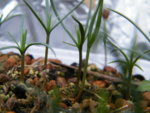Wires_Guy_wires
Imperial Masterpiece
Right, right, before you jump on the bandwagon: I know.
I know it shouldn't be done and I know this could end in disaster (losing 200 seedlings). Frankly, I don't care. It's my money, my time, my electrical bill.
Take a seat and enjoy the ride, maybe laugh in my face at the final station, or just get in another train.
This is an experiment, nothing more, nothing less. I might get something out of it, I might not.
After some special junipers decided to germinate, I had no place to put them. I'm not sure if they are hardy and I'm not going to take a risk with just 2% germination rates and seeds being unavailable for 95% of the year (apart from being expensive). So my phoenicean junipers were put under LED lights. To much of my surprise, they acted just like the junipers I have outdoors. They don't seem to stretch and they don't seem to go wonky like plants looking for light tend to do.
So naturally, one would wait for a longer period to check if these conditions are right. I did no such thing.
10 grams of osteosperma, scopulorum and ERC went through stratification; a few months in the fridge before they were placed outdoors to get some frost. They started to germinate during some warmer days and away they went.. Indoors. Under LED. More popped up!
Some packages arrived, oh boy! Now there are 75 chinensis seeds being stratified and 75 went straight into the soil a few days ago.
Will 45W of 6500K LED be sufficient? I believe not. But! If the distance between plant and light is smaller, it seems to keep them from stretching. I'm making a raised stand as we speak, so I can lift the others as well.

Subjects 1 and 2: J. phoenicea var. turbinata. Distance to LED is about 10cm. The left one had an auxin accident. And that's a spider web btw.

Subject group 2: J. osteosperma. They don't seem to stretch a lot, but we'll see how the internodes will come out. Distance to LEDs is about 30cm.

Subject group 3: J. Vagina. These are actually stretching and looking for light. Might be a germination coupled auxin thingy. Distance to LEDs is about 30cm.

Subject group 4: J. scopulorum. These are stretching as well, but some are not. Distance to LEDs is about 30cm.
This thread is meant to keep track of their performance under LED light, and to see how on earth I'm ever getting them outdoors. Have you ever transferred a LED-grown plant to full sun? If you have.. You know what I'm talking about. If you haven't, be prepared to see all of them being burned alive by some soft sunlight.
It's quite the challenge! And I like it that way.
Happy new year everyone!
I know it shouldn't be done and I know this could end in disaster (losing 200 seedlings). Frankly, I don't care. It's my money, my time, my electrical bill.
Take a seat and enjoy the ride, maybe laugh in my face at the final station, or just get in another train.
This is an experiment, nothing more, nothing less. I might get something out of it, I might not.
After some special junipers decided to germinate, I had no place to put them. I'm not sure if they are hardy and I'm not going to take a risk with just 2% germination rates and seeds being unavailable for 95% of the year (apart from being expensive). So my phoenicean junipers were put under LED lights. To much of my surprise, they acted just like the junipers I have outdoors. They don't seem to stretch and they don't seem to go wonky like plants looking for light tend to do.
So naturally, one would wait for a longer period to check if these conditions are right. I did no such thing.
10 grams of osteosperma, scopulorum and ERC went through stratification; a few months in the fridge before they were placed outdoors to get some frost. They started to germinate during some warmer days and away they went.. Indoors. Under LED. More popped up!
Some packages arrived, oh boy! Now there are 75 chinensis seeds being stratified and 75 went straight into the soil a few days ago.
Will 45W of 6500K LED be sufficient? I believe not. But! If the distance between plant and light is smaller, it seems to keep them from stretching. I'm making a raised stand as we speak, so I can lift the others as well.

Subjects 1 and 2: J. phoenicea var. turbinata. Distance to LED is about 10cm. The left one had an auxin accident. And that's a spider web btw.

Subject group 2: J. osteosperma. They don't seem to stretch a lot, but we'll see how the internodes will come out. Distance to LEDs is about 30cm.

Subject group 3: J. Vagina. These are actually stretching and looking for light. Might be a germination coupled auxin thingy. Distance to LEDs is about 30cm.

Subject group 4: J. scopulorum. These are stretching as well, but some are not. Distance to LEDs is about 30cm.
This thread is meant to keep track of their performance under LED light, and to see how on earth I'm ever getting them outdoors. Have you ever transferred a LED-grown plant to full sun? If you have.. You know what I'm talking about. If you haven't, be prepared to see all of them being burned alive by some soft sunlight.
It's quite the challenge! And I like it that way.
Happy new year everyone!




